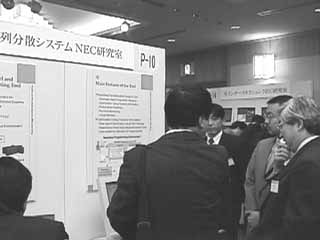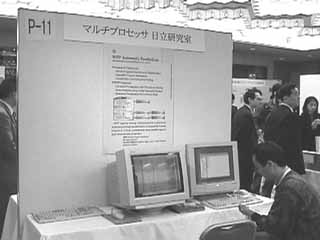Construction of Virtual Private Distributed Systems by Comet
Parallel Distributed System Fujitsu Laboratory
http://www.pds-flab.rwcp.or.jp/comet/ResearchAchieve.html

|
The Parallel and Distributed Systems Fujitsu Laboratory is developing
an ultra-high-speed communication technology called Comet (COMmunication
Enterprising Technology) aiming at realizing VPDS (Virtual Private
Distributed Systems). VPDS connects computers distributed on the Internet
using gigabit transmission technology such as Gigabit Ethernet, SONET
and WDM to allow these computers to function as a private virtual
parallel and distributed system. At RWC 2000, we exhibits the Comet
NP communication processor, Comet VIA communication architecture,
Comet DV/IP application system and other technologies that are being
developed. (http://www.pds-flab.rwcp.or.jp) |
A Programming Environment for Heterogeneous Parallel and Distributed
Systems
Parallel and Distributed System NEC Laboratory
http://www.rwcp.or.jp/activities/achievements/PD/nec/index.htm

|
The Parallel and Distributed Systems NEC Laboratory is carrying
out research and development of a programming support environment
to facilitate development of applications for "heterogeneous parallel
and distributed systems" that are created by connecting supercomputers.
This environment consists of three parts: library, compiler and programming
tools. The demonstration will focus on the programming tools. These
tools include a function for automatically allocating data or processing
to a parallel processor, a function for estimating the performance
before execution, and a function for optimizing the program using
runtime information. The tool can transform a program written in Fortran
language for a conventional single system into a parallel program
for heterogeneous parallel systems by a simple, visual operation.
|
Interprocedural Parallelizing Compiler WPP
Multi-Processor Computing Hitachi Laboratory
http://www.rwcp.or.jp/activities/achievements/MP/hitachi/PDC-hitachi.html

|
The mainstream of supercomputers at present is the parallel computer
that boosts the performance of a program by running its multiple CPUs
simultaneously. In order to perform high-speed computation on the
parallel computers, programmers must parallelize a wide range of the
program, that is, write the program so that multiple CPUs can be efficiently
used in the range.
Multiprocessor Computing Hitachi laboratory has been prototyping
an automatic parallelization tool WPP (Whole Program Parallelizer).
WPP can parallelize a wider range of a program by analyzing all the
procedures comprising the program together and output the result as
an OpenMP program.
By using WPP, users can execute existing programs without modification
on the various types of parallel computers for which the OpenMP compiler
is available.
In our demonstration, using an industry-standard benchmark program
as an example, we will graphically show both the process of analyses
in WPP and the resulting OpenMP program.
|


